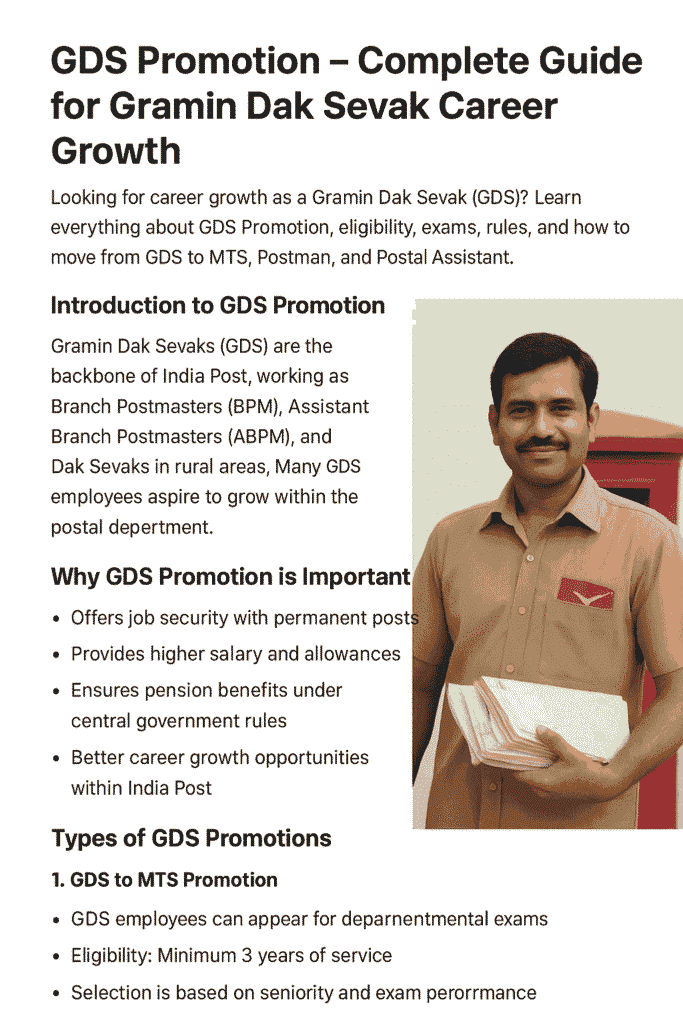Introduction to GDS Promotion
Gramin Dak Sevaks (GDS) are the backbone of India Post, working as Branch Postmasters (BPM), Assistant Branch Postmasters (ABPM), and Dak Sevaks in rural areas. Many GDS employees aspire to grow within the postal department. The good news is that GDS Promotion opportunities are available, allowing you to move into permanent departmental posts like Multi-Tasking Staff (MTS), Postman, Mail Guard, and Postal Assistant.
In this blog, we’ll explain the complete process of GDS Promotion, eligibility criteria, exams, rules, and tips to prepare.
Why GDS Promotion is Important
- Offers job security with permanent posts
- Provides higher salary and allowances
- Ensures pension benefits under central government rules
- Better career growth opportunities within India Post
Types of GDS Promotions
1. GDS to MTS Promotion
– GDS employees can appear for departmental exams for MTS posts.
– Eligibility: Minimum 3 years of service.
– Selection is based on seniority and exam performance.
2. GDS to Postman / Mail Guard Promotion
– After gaining experience,GDS can apply for Postman or Mail Guard posts.
– Eligibility: 5 years of service(GDS+MTS) + exam qualification.
– Provides better pay scale and departmental benefits.
3. GDS to Postal Assistant / Sorting Assistant Promotion
– One of the most desired promotions.
– GDS can appear for LDCE (Limited Departmental Competitive Exam).
– Eligibility: 8 years of service for one who joined after 17 june 2022.
– This role includes clerical and administrative responsibilities.
Eligibility Criteria for GDS Promotion
- Minimum 3 years continuous service (for MTS)
- Minimum 5 years continuous service (for Postman,Mail guard)
- Minimum 8 years continuous service (for Postal Assistant) who joined after 17 june 2022.
- Must meet educational qualifications required for the post
- Age relaxation is applicable for SC/ST/OBC categories
GDS Promotion Exam Pattern
The GDS Promotion Exams are conducted by the Postal Department region-wise.
- Mode: Offline (written test)
- Subjects Covered:
- General Knowledge
- Mathematics
- Reasoning Ability
- English & Regional Language
- Postal Department Rules
- Selection Process:
- Written Exam
- Document Verification
- Final Selection List
Tips to Crack GDS Promotion Exam
- Focus on Postal Manual rules and regulations
- Practice previous year question papers
- Revise basic maths and reasoning daily
- Read India Post circulars and updates
- Join mock tests and online classes for better preparation
Benefits After GDS Promotion
- Increased salary package (basic pay + allowances)
- Job stability in departmental posts
- Eligibility for pension benefits after retirement
- More chances of further promotions (e.g., Supervisor, Inspector, etc.)
Frequently Asked Questions (FAQs)
Q1. Can a GDS become a Postman?
Yes, after 5 years of service, GDS can apply for Postman promotion exam.
Q2. What is the highest post a GDS can get?
A GDS can reach up to Postal Assistant / Sorting Assistant and then continue promotion to higher departmental posts.
Q3. Is there an age limit for GDS Promotion?
Yes, age limits apply depending on category, but relaxations are provided for SC/ST/OBC candidates.
Q4. How many years does it take for GDS Promotion?
Minimum 3 years for MTS/Postman and 5 years for Postman, Mail guard and 8 years for Postal Assistant.
Q5. Why is GDS Promotion important?
GDS Promotion ensures better job security, higher salary, pension benefits, and long-term career growth within India Post.
Conclusion
GDS Promotion is a golden opportunity for Gramin Dak Sevaks who want to secure their future with permanent posts in India Post. With proper preparation and dedication, GDS employees can successfully move up the career ladder.
👉 If you are preparing for GDS Promotion exams, start early, stay updated with postal notifications, and practice regularly. Your hard work can lead you from GDS to Postal Assistant and beyond!

Leave a Reply